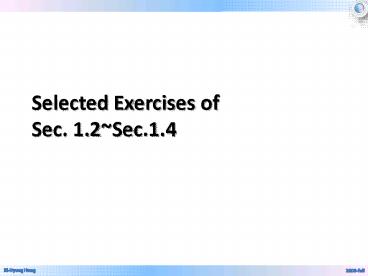Selected Exercises of Sec. 1.2~Sec.1.4 - PowerPoint PPT Presentation
1 / 14
Title:
Selected Exercises of Sec. 1.2~Sec.1.4
Description:
Title: 1 Author: Microsoft Corporation Last modified by: Owner Created Date: 10/5/2006 4:04:58 AM Document presentation format: (4:3) – PowerPoint PPT presentation
Number of Views:53
Avg rating:3.0/5.0
Title: Selected Exercises of Sec. 1.2~Sec.1.4
1
Selected Exercises of Sec. 1.2Sec.1.4
2
Sec. 1.2 Exercise 41
- p, q, r ?? ? ?? ??? ?? ??, ? ?? ???? ??? ?? ?????
????. - Find a compound proposition involving the
propositional variable p, q, and r that is true
when exactly two of p, q, and r are true and is
false otherwise. - Solution (p ? q ? ?r) ? (p ? ?q ? r) ? (?p ? q
? r).
3
Sec. 1.2 Exercise 55
- How many different truth tables of compound
propositions are there that involve the
propositional variables p and q? - Solution16
4
Sec. 1.3 Exercise 7
- Translate these statements into English, where
C(x) is x is a comedian and F(x) is x is
funny and the domain consists of all people. - a) ?x (C(x) ? F(x))
- Every comedian is funny.
- b) ?x (C(x) ? F(x))
- Every person is a funny comedian.
5
Cont.
- c) ?x (C(x) ? F(x))
- There exists a person such that if she or he is
a comedian, then she or he is funny. - d) ?x (C(x) ? F(x))
- Some comedians are funny.
6
Sec. 1.3 Exercise 29
- Express each of these statements using logical
operators, predicates, and quantifiers. - Solution Let T(x) mean that x is a tautology and
C(x) mean that x is a contradiction. - a) Some propositions are tautologies. ?x T(x)
- b) The negation of a contradiction is a tautology
- ?x (C(x) ? T(? x))
7
Cont.
- c) The disjunction of two contingencies can be a
tautology. - ?x ?y(?T(x) ? ?C(x) ? ?T(y) ? ?C(y) ? T(x ? y))
- c) The conjunction of two tautologies is a
tautology. - ?x?y (T(x) ? T(y) ? T(x ? y))
8
Sec. 1.4 Exercise 1
- Translate these statements into English, where
the domain for each variable consists of all real
number. - a) ?x?y(x lt y)
- For every real number x there exists a real
number y such that x is less than y.
9
Cont.
- b) ?x?y(((x 0) ? (y 0)) ? xy 0))
- For every real number x and real number y, if x
and y are both nonnegative, then their product is
nonnegative. - c) ?x?y?z (xy z)
- For every real number x and real number y, there
exists a real number z such that xy z.
10
Sec. 1.4 Exercise 11
- Let S(x) be the predicate x is a student, F(x)
the predicate x is faculty member, and A(x, y)
the predicate x has asked y a question, where
the domain consists of all people associated with
your school. Use quantifiers to express each of
these statements. - a) Lois has asked Professor Michaels a question.
- gt A(Lois, Professor Michaels)
11
Cont.
- b) Every student has asked Professor Gross a
question. - gt ?x(S(x) ? A(x, Professor Gross)
- c) Every faculty member has either asked
Professor Miller a question or been asked a
question by Professor Miller. - gt ?x(F(x) ? (A(x, Professor Miller) ?
A(Professor Miller, x)
12
Cont.
- d) Some student has not asked any faculty member
a question. - gt ?x(S(x) ? ?y(F(y) ? ? A(x, y)))
- e) There is a faculty member who has never been
asked a question by a student. - gt ?x(F(x) ? ?y(S(y) ? ? A(y, x)))
13
Cont.
- f) Some student has asked every faculty member a
question. - gt ?y(F(y) ? ?x(S(x) ? A(y, x)))
- g) There is a faculty member who has asked every
other faculty member a question. - gt ?x(F(x) ? ?y((F(y) ? (y? x)) ? A(x, y)))
14
Cont.
- h) Some student has never been asked a question
by a faculty member. - gt ?x(S(x) ? ?y(F(y) ? ? A(y, x)))































